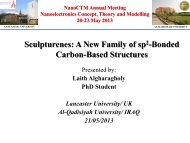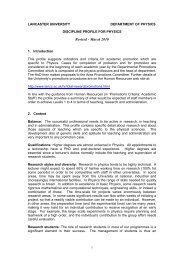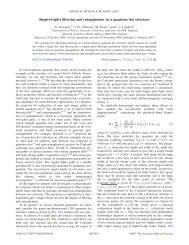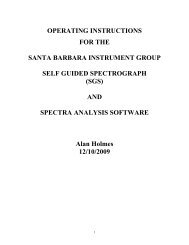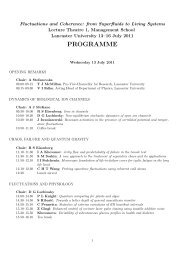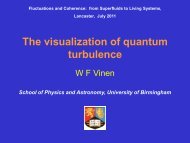Abstract - Physics at Lancaster University
Abstract - Physics at Lancaster University
Abstract - Physics at Lancaster University
Create successful ePaper yourself
Turn your PDF publications into a flip-book with our unique Google optimized e-Paper software.
Single Cooper pair tunneling in small Josephson junction circuits and superconducting nanowiresA. B. ZorinPhysikalisch-Technische Bundesanstalt, 38116 Braunschweig, GermanyDevelopment of the technology for fabric<strong>at</strong>ion of small structures had dram<strong>at</strong>ic impact on the researchof single charge effects in the superconducting circuits. The class of such circuits includes the singleCooper pair transistors, serial arrays of small Josephson junctions, etc. and, recently, superconductingnanowires enabling under certain conditions the quantum slips of superconducting phase. In my talk Iwill review the research on the Bloch oscill<strong>at</strong>ions in the Josephson circuits and their phase locking byexternal ac drive and focus on the recent experiments with NbSi nanowires, demonstr<strong>at</strong>ing manipul<strong>at</strong>ionof individual Cooper pairs leading to quantum interference of voltages. Prospects of the single Cooperpair nanowires and possible applic<strong>at</strong>ion of these circuits in metrology will also be discussed.
Thermoelectric Properties of Graphene –based MolecularJunctionsAmaal AL-backri , Colin Lambert<strong>Lancaster</strong> <strong>University</strong><strong>Abstract</strong>:Single-molecule electronics offers new opportunities for tuning the thermoelectricalproperties of organic m<strong>at</strong>erials. In the liter<strong>at</strong>ure, these mainly involve tuning the localdensity of st<strong>at</strong>es of the molecule to maximise the slope of the transmission coefficientnear the Fermi energy. We demonstr<strong>at</strong>e a new str<strong>at</strong>egy to enhance the thermoelectricperformance of graphene-based molecular junctions, which involves tuning the localdensity of st<strong>at</strong>es of graphene edges. We show th<strong>at</strong> thermoelectric properties areinfluenced by the chemical termin<strong>at</strong>ion of graphene electrodes and the n<strong>at</strong>ure of thebinding of the molecule to the electrodes. Through a suitable combin<strong>at</strong>ion of theseparameters, large enhancements of the thermopower and figure of merit are possible.
Quantum Communic<strong>at</strong>ions in the Real WorldAndrew ShieldsToshiba Research Europe Limited208 Cambridge Science Park, Milton Road, Cambridge. CB4 0GZ. U.K.enquires@crl.toshiba.co.ukwww.quantum.toshiba.co.ukApplying quantum theory to inform<strong>at</strong>ion systems allows functionalities beyond thecapabilities of conventional network and computer technology. For example, it provides adirect test of communic<strong>at</strong>ion secrecy, imaging beyond classical resolution limits andefficient solution of comput<strong>at</strong>ional problems th<strong>at</strong> are virtually intractable using ordinaryprocessors.In this talk I will discuss recent progress and challenges in realising a practical technologyfor quantum communic<strong>at</strong>ions. Key to this is the development of semiconductor devicesfor the gener<strong>at</strong>ion and detection of quantum light st<strong>at</strong>es. Quantum cryptography systemsrely upon avalanche photodiodes th<strong>at</strong> can count photons to very high r<strong>at</strong>es, whileentangled light emitting diodes have recently enabled for electrically powered quantumteleporters.
Scanning G<strong>at</strong>e Microscopy of Quantum Dots:Fabry-Perrot Interferences and Thermally Induced P<strong>at</strong>tern of RingsAndrii Kleshchonok, Geneviève Fleury, Jean-Louis PichardService de Physique de l'Et<strong>at</strong> Condensé (CNRS URA 2464),IRAMIS/SPEC, CEA Saclay, 91191 Gif-sur-Yvette, FranceThermally induced rings can be seen in addition to Fabry-Perrot interference fringes spaced by half theFermi wavelength when one studies the conductance of the interferometer formed in a two dimensionalelectron gas (2DEG) between a nanostructured quantum contact and the charged tip of a scanning g<strong>at</strong>emicroscope. If the contact is made of a quantum dot with odd number of electrons opened in the middleof a Kondo valley, we show how the loc<strong>at</strong>ion of the rings allows to measure by electron interferometrythe magnetic moment of the dot above the Kondo temper<strong>at</strong>ure.
Spin manipul<strong>at</strong>ion in moving quantum dots via the spin-orbit interactionAnton Ramsak, Ljubljana <strong>University</strong>An exact solution is derived for the wavefunction of an electron in a semiconductorquantum wire with spin–orbit interaction and driven by external time-dependentharmonic confining potential. The formalism allows analytical expressions forvarious quantities to be derived, for example spin and pseudo-spin rot<strong>at</strong>ions, energyand occup<strong>at</strong>ion probabilities for excited st<strong>at</strong>es. It is demonstr<strong>at</strong>ed how perfect spinand pseudo-spin flips can be achieved <strong>at</strong> high frequencies of the order of , theconfining potential level spacing. By an appropri<strong>at</strong>ely chosen driving term, spinmanipul<strong>at</strong>ion can be exactly performed far into the non-adiab<strong>at</strong>ic regime. Theimplic<strong>at</strong>ions for spin-polarized emission and spin-dependent transport are alsodiscussed.
Scanning g<strong>at</strong>e microscopy: General theory for weak probes and results for aballistic cavityDietmar Weinmann, <strong>University</strong> of StrasbourgIn scanning g<strong>at</strong>e microscopy (SGM), the conductance change of a device induced bya local perturb<strong>at</strong>ion (a charged AFM tip) is measured as a function of the tipposition, yielding sp<strong>at</strong>ially resolved inform<strong>at</strong>ions on the transport properties of thesample.In order to provide an interpret<strong>at</strong>ion of wh<strong>at</strong> precisely is being measured, wepresent a theory of the conductance changes induced by non-invasive weak SGMtips [1]. Asc<strong>at</strong>tering approach yields expressions for the first and second order conductancechanges due to the perturb<strong>at</strong>ion by the tip potential. Only in special cases, such asth<strong>at</strong> of a centrally symmetric quantum point contact in the conductancequantiz<strong>at</strong>ion regime, the SGM response can be unambiguously rel<strong>at</strong>ed with the localcurrent density. In the non-linear transport regime, the breaking of the left-rightsymmetry of the device by the presence of the tip leads to a noticeable asymmetry ofthe current-voltage characteristic [2].In the regime of strong tips, we have performed numerical calcul<strong>at</strong>ions for a modelstructure th<strong>at</strong> corresponds to a recent SGM experiment [3] on a large ballistic cavitydefined in a semiconductor heterostructure. When the tip is in a region close to theentry/exit of the cavity, two parallel conduction channels arise, and result in acharacteristic fringe p<strong>at</strong>tern. When the tip is inside the stadium large fluctu<strong>at</strong>ions ofthe conductance with the tip position are visible. Quantum calcul<strong>at</strong>ions using therecursive Green function method agree well with the experimentally measured d<strong>at</strong>a.Some of the main fe<strong>at</strong>ures are even captured by a classical approach based onelectron trajectories through the structure.[1] C. Gorini, R.A. Jalabert, W. Szewc, S. Tomsovic, and D. Weinmann,arXiv:1302.1151v1[2] C. Gorini, R.A. Jalabert, and D. Weinmann, in prepar<strong>at</strong>ion (2013)[3] A.A. Kozikov, D. Weinmann, C. Rössler, T. Ihn, K. Ensslin, C. Reichl, and W.Wegscheider, in prepar<strong>at</strong>ion (2013)
Quantum St<strong>at</strong>e Engineering with QubitsGerd SchönKarlsruhe Institute of Technology, GermanyThe improving level of control of superconducting qubits opens p<strong>at</strong>hs to use them for variousquantum st<strong>at</strong>e engineering applic<strong>at</strong>ions. Spectaculars results were obtained forsuperconducting qubits coupled to superconducting reson<strong>at</strong>ors. In these circuits conceptsoriginally introduced in the field of quantum optics could be realized with unprecedentedquality. We analyzed several such experiments which demonstr<strong>at</strong>ed lasing and cooling of theelectromagnetic modes. They differed in the mechanisms for cre<strong>at</strong>ing the popul<strong>at</strong>ioninversion. This includes a conventional driving via a 3 rd level, popul<strong>at</strong>ion inversion in thedressed st<strong>at</strong>e basis, but also the Sisyphus mechanism for damping and amplific<strong>at</strong>ion. Weextended the usual quantum optics description to account for strong qubit-reson<strong>at</strong>or couplingand included the effects of low-frequency noise.Similar scenarios are to be expected in circuits built from semiconducting quantum dots andsuitable high-Q reson<strong>at</strong>ors. In th<strong>at</strong> case we observe strong correl<strong>at</strong>ions between the lasingst<strong>at</strong>e of the system and its transport properties.As an applic<strong>at</strong>ion of the qubit technology we mention th<strong>at</strong> superconducting qubits have beenapplied to perform spectroscopy on m<strong>at</strong>erial specific 2-level fluctu<strong>at</strong>ors.
Lambda Systems for popul<strong>at</strong>ion transfer in superconductingnanocircuitsGiuseppe FalciDipartimento di Fisica e Astronomia Università di C<strong>at</strong>aniaThe implement<strong>at</strong>ion of a Lambda scheme in superconducting artificial <strong>at</strong>omscould allow detection of stimul<strong>at</strong>ed Raman adiab<strong>at</strong>ic passage (STIRAP) andother quantum manipul<strong>at</strong>ions in the microwave regime. However symmetrieswhich on one hand protect the system against decoherence, yield selectionrules which may cancel coupling to the pump external drive. The trade-offbetween efficient coupling and decoherence due to broad-band colored Noise(BBCN), which is often the main source of decoherence is addressed, in theclass of nanodevices based on the Cooper pair box (CPB) design. We studytransfer efficiency by STIRAP, showing th<strong>at</strong> substantial efficiency is achievedfor off-symmetric bias only in the charge-phase regime. We find a number ofresults uniquely due to non-Markovianity of BBCN, namely: (a) the efficiencyfor STIRAP depends essentially on noise channels in the trapped subspace;(b) low-frequency fluctu<strong>at</strong>ions can be analyzed and represented as fictitiouscorrel<strong>at</strong>ed fluctu<strong>at</strong>ions of the detunings of the external drives; (c) a simplefigure of merit for design and oper<strong>at</strong>ing prescriptions allowing theobserv<strong>at</strong>ion of STIRAP is proposed. The emerging physical picture alsoapplies to other classes of coherent nanodevices subject to BBCN.Next we introduce a three-photon scheme allowing to obtain a Lambdaconfigur<strong>at</strong>ion <strong>at</strong> the symmetry point. Couplings and noise now both increasewith the Josephson energy, this effect being compens<strong>at</strong>ed by leakage from thethree-level subspace due to the spectrum becoming more and more harmonic.Finally we present a protocol where coherent popul<strong>at</strong>ion transfer is obtainedwith an always on coupling switched by a suitable detuning. The absence of anexact dark st<strong>at</strong>e makes the phenomenon of disruptive interference non-trivial.This configur<strong>at</strong>ion may allow to couple the device with electrical ormechanical modes of solid-st<strong>at</strong>e reson<strong>at</strong>ors.
Electrical Transport in Sculpturene-Based Systems for Sensing Applic<strong>at</strong>ionsH<strong>at</strong>ef Sadeghi, <strong>Lancaster</strong> <strong>University</strong>As discussed in previous talk, sculptured carbon based structures calledsculpturenes are novel allotropes of carbon, with new topologies and geometries.They could be formed by sculpting selected shapes from stacked graphene layersand allowing the shapes to reconstruct. Here we discuss the electrical properties ofsome of these structures. In particular, results are presented for the electricalconductance of sculpturene tori connected to external electrodes. These structurescontain a hydrophobic pocket, which can encapsul<strong>at</strong>e molecules from a surroundingenvironment. We demonstr<strong>at</strong>e th<strong>at</strong> the electrical conductance is sensitive to suchencapsul<strong>at</strong>ion, thereby providing a new mechanism for environmental sensing.
Explor<strong>at</strong>ions in adiab<strong>at</strong>ic quantum computingJoachim Wabnig, Nokia Research Center, Cambridge, UK.The big promise of quantum computing is a huge speedup compared to its classicalcounterpart. Twenty years after the discovery of Shor's factoring algorithm a wholezoo of quantum algorithms exists with speedups ranging from polynomial tosuperpolynomial, but universal quantum computers able to run these algorithmswill remain out of reach for years to come. A more feasible approach to quantumcomputing th<strong>at</strong> emerged in recent years is to abandon universality and concentr<strong>at</strong>ethe efforts on hardware th<strong>at</strong> can n<strong>at</strong>ively solve quadr<strong>at</strong>ic binary optimis<strong>at</strong>ionproblems. I will review an implement<strong>at</strong>ion using superconducting qubits anddiscuss wh<strong>at</strong> kind of problems can be solved on the hardware. A connection will bemade between binary optimis<strong>at</strong>ion problems and machine learning. Finally I willpoint out problems of interest and encourage the audience to scr<strong>at</strong>ch their heads.
St<strong>at</strong>istical Topological Insul<strong>at</strong>orsJon<strong>at</strong>han Edge, Leiden <strong>University</strong>We define a class of insul<strong>at</strong>ors with gapless surface st<strong>at</strong>es protected fromlocaliz<strong>at</strong>ion due to the st<strong>at</strong>istical properties of a disordered ensemble, namely due tothe ensemble's invariance under a certain symmetry. We show th<strong>at</strong> these insul<strong>at</strong>orsare topological, and are protected by a Z2 invariant. Finally, we prove th<strong>at</strong> everytopological insul<strong>at</strong>or gives rise to an infinite number of classes of st<strong>at</strong>isticaltopological insul<strong>at</strong>ors in higher dimensions. Our conclusions are confirmed bynumerical simul<strong>at</strong>ions.
Spin lifetime measurements in a Si/SiGe double quantum dot.J. R. Prance 1 , Zhan Shi 1 , C. B. Simmons 1 , X. Wu 1 , D. E. Savage 1 , M. G. Lagally 1 , L. R. Schreiber 2 , L. M. K.Vandersypen 2 , Mark Friesen 1 , Robert Joynt 1 , S. N. Coppersmith 1 , and M. A. Eriksson 1(1) <strong>University</strong> of Wisconsin-Madison(2) Kavli Institute of Nanoscience, TU DelftThe two-electron singlet and triplet spin st<strong>at</strong>es in a double quantum dot form the basis for a logicalqubit th<strong>at</strong> combines fast manipul<strong>at</strong>ion and a spin readout mechanism. Here we present lifetimemeasurements of these st<strong>at</strong>es in a Si/SiGe double quantum dot. The st<strong>at</strong>es are measured by usingPauli spin blockade to perform spin-to-charge conversion, and by detecting the charge st<strong>at</strong>e of thedouble dot in real time using a nearby quantum-point-contact charge sensor. At zero magnetic fieldthe st<strong>at</strong>e lifetimes are found to be ~10ms. As the magnetic field increases, the lifetime of the spinpolarizedT- triplet increases, reaching 3 seconds <strong>at</strong> 1T. This work was supported by ARO and LPS(W911NF-08-1-0482) and by the United St<strong>at</strong>es Department of Defense. The views and conclusionscontained in this document are those of the authors and should not be interpreted as representingthe official policies, either expressly or implied, of the US Government.
Engineering the Thermopower of C 60 Molecular JunctionsCharalambos Evangeli 1 , K<strong>at</strong>alin Gillemot 2 , Edmund Leary 1,3 , M. Teresa González 3 , GabinoRubio-Bollinger 1,4 , Colin J. Lambert 2 and Nicolás Agraït 1,3,41 Departamento de Física de la M<strong>at</strong>eria Condensada,Universidad Autónoma de Madrid, Madrid, Spain2 Department of <strong>Physics</strong>, <strong>Lancaster</strong> <strong>University</strong>, <strong>Lancaster</strong>, United Kingdom3 Instituto Madrileño de Estudios Avanzados en Nanociencia IMDEA-Nanociencia, Madrid, Spain4 Instituto Universitario de Ciencia de M<strong>at</strong>eriales ‘‘Nicolás Cabrera’’, Universidad Autónoma de Madrid,Madrid, SpainThe development of new higher-efficiency and low-cost thermoelectric devices is a desirabletechnology th<strong>at</strong> would allow direct he<strong>at</strong>-to-electrical energy conversion from otherwisewasted low-level he<strong>at</strong> sources and would have an enormous impact on global energyconsumption. Nanoscale systems and especially organic junctions are very promising in thisrespect, due to the fact th<strong>at</strong> transport takes place through discrete energy levels 1 . A number oftechniques for enhancing thermoelectric performance have been suggested, but to d<strong>at</strong>e nonehas led to sufficiently-high values of figure of merit (ZT). We propose a new str<strong>at</strong>egy 2 forenhancing the thermoelectric performance of single-molecule devices, based on controllingthe coupling between C 60 molecules. The str<strong>at</strong>egy is demonstr<strong>at</strong>ed using a combin<strong>at</strong>ion of anew experimental technique and first principles theory. In contrast to all previousmeasurements, the newly-developed measurement technique allows us to measuresimultaneously the electrical conductance and thermopower of single and coupled molecules,and unambiguously characterize these <strong>at</strong> the single molecule level. We demonstr<strong>at</strong>e th<strong>at</strong>thermopower can be almost doubled by tuning the interaction between two neighbouring C 60molecules under ambient conditions and further doubled by coupling three C 60 s. This trend isaccompanied by an unprecedented increase in the thermoelectric figure of merit ZT.[1] Malen, J.A.; Yee, S.K.; Majumdar, A.; Segalman, R.A. Fundamentals of energy transport, energy conversion,and thermal properties in organic–inorganic heterojunctions, Chem. Phys. Lett. 2010, 491, 109-122.[2] Evangeli, C.; Gillemot, K.; Leary, E.; González, M.T.; Rubio-Bollinger, G.; Lambert, C.J.; Agraït, N.Engineering the Thermopower of C 60 Molecular Junctions, Nano Lett. 2013, Article ASAP.
TitleSculpturenes: A New Family of sp 2 -Bonded Carbon-Based StructuresLaith Algharagholy, Steven W. D. Bailey, Thomas Pope, and Colin J. Lambert<strong>Lancaster</strong> <strong>University</strong>/UKAl-Qadisiyah <strong>University</strong>/Iraq<strong>Abstract</strong>We demonstr<strong>at</strong>e a technique for cre<strong>at</strong>ing unique forms of pure sp 2 -bondedcarbon and unprecedented heteromolecules. These new structures, which werefer to as sculpturenes, are formed by sculpting selected shapes from bilayergraphene, heterobilayers, or multilayered m<strong>at</strong>erials and allowing the shapes tospontaneously reconstruct. The simplest sculpturene is topologically equivalentto a torus, with dimensions comparable to those of fullerenes. The topology ofthese new molecular structures is stable against <strong>at</strong>omic-scale defects. Wedemonstr<strong>at</strong>e th<strong>at</strong> sculpturenes can form the basic building blocks of hollow,multiconnected structures.
St<strong>at</strong>istics of single electron emittersMarkus Buttiker, <strong>University</strong> of GenevaWe develop a novel approach to address the st<strong>at</strong>istical properties of periodicallydriven systems such as quantum pumps and mesoscopic capacitors working in thesingle electron emission regime. Our approach focuses on the distribution functionof the waiting time between the arrival of charge carriers. Such short time st<strong>at</strong>isticspermits to ascertain th<strong>at</strong> only one electron is emitted during each driving cycle. Forperiodically driven systems the waiting time distribution describes the crossoverfrom poissonian electron transfer far from optimal conditions to electron emissionwhich is synchronized to the pump signal up to the uncertainty limit required by theescape-time [1]. To extend our approach to fully quantum mechanical systems wehave investig<strong>at</strong>ed the waiting time distribution of a quantum point contact under dcbias. In the zero-temper<strong>at</strong>ure limit this corresponds to an incident st<strong>at</strong>e in whichelectrons are as closely space as required by the Pauli principle. We find th<strong>at</strong> thewaiting time distribution exhibits a Wigner-Dyson distribution for perfecttransmission and exhibits a crossover to a Poisson distribution close to pinch-off ofthe quantum point contact. We discuss several analogies with energy level st<strong>at</strong>isticsand random m<strong>at</strong>rix theory [2]. Additional results for the waiting time distributionfor dynamical quantum mechanical sc<strong>at</strong>terers are presented for oscill<strong>at</strong>ing barrierand for Lorentzian pulses.[1 ] M. Albert, C. Flindt, M. Büttiker, Phys. Rev. Lett. 107, 086805 (2011).[2 ] M. Albert, G. Haack, C. Flindt, M. Büttiker, Phys. Rev. Lett. 108, 186806 (2012).[3] D. Dasenbrook, C. Flindt and M. Buttiker, (unpublished).
Spinful Kitaev model for spin-singlet topological superconductors and–periodic Josephson transportPanagiotis Kotetes 1 , Alexander Shnirman 2 , Gerd Schön 11 Institut für Theoretische Festkörperphysik, Karlsruhe Institute of Technology, 76128 Karlsruhe, Germany2 Institut für Theorie der Kondensierten M<strong>at</strong>erie, Karlsruhe Institute of Technology, 76128 Karlsruhe, GermanyCurrent trends in the field of quantum inform<strong>at</strong>ion rel<strong>at</strong>e to topological quantum computing based onMajorana fermions. Recent experiments involving devices consisting of a Rashba spin-orbit coupledsemiconducting wire in proximity to an s-wave superconductor, have provided striking results when aZeeman field is applied, th<strong>at</strong> could be associ<strong>at</strong>ed with the presence of Majorana fermions. From <strong>at</strong>heoretical point of view, in the infinite magnetic field limit the above system is equivalent to a spinlessp-wave superconductor and can be effectively described by Kitaev’s celebr<strong>at</strong>ed l<strong>at</strong>tice model. Thismodel owes the distinctive property of yielding Majorana fermions which are localized <strong>at</strong> the edges. Sofar, a vast number of previous studies were based on this mapping to Kitaev’s model, neglecting in thismanner the possibility of actively manipul<strong>at</strong>ing the spin degree of freedom. To tackle this problem, weconstruct an effective spinful Kitaev model th<strong>at</strong> can be used for finite magnetic fields. By employingthe particular model, we study the magnetically controllable 4-periodic Josephson transport th<strong>at</strong>origin<strong>at</strong>es from two coupled neighbouring Majorana fermions th<strong>at</strong> reside on two different wires.Although fundamental, the l<strong>at</strong>ter effects lack of a complete investig<strong>at</strong>ion for this type of devices. Ourresults are also in agreement with previous rel<strong>at</strong>ed Majorana-fermion-medi<strong>at</strong>ed magneto-Josephsoneffects [1]. Finally, this model can crucially facilit<strong>at</strong>e the development of new spin-based quantumcomputing applic<strong>at</strong>ions.[1] P. Kotetes, A. Shnirman and G. Schön, arXiv:1207.2691 (to appear in JKPS)
Spin thermoelectrics in a disordered two-dimensional Fermi gasJ. Borge 1 , Cosimo Gorini 2 , and Roberto Raimondi 1Dipartimento di M<strong>at</strong>em<strong>at</strong>ica e Fisica, Università Roma Tre,Via della Vasca Navale 84, 00146 Roma, Italy and2 Institut für Physik, Universität Augsburg, 86135 Augsburg, GermanyWe study the connection between the spin-he<strong>at</strong> and spin-charge response in a disordered Fermigas with spin-orbit coupling. It is shown th<strong>at</strong> the r<strong>at</strong>io between the above responses can beexpressed as the thermopower S = −(πk B) 2 Tσ ′ /3eσ times a number R s which depends on thestrength and type of the spin-orbit couplings considered. The general results are illustr<strong>at</strong>edby examining different two-dimensional electron or hole systems with different and competingspin-orbit mechanisms, and we conclude th<strong>at</strong> a metallic system could prove much more efficient asa he<strong>at</strong>-to-spin than as a he<strong>at</strong>-to-charge converter.J. Borge, C. Gorini, R. Raimondi, Physical Review 87, 085309 (2013).
St<strong>at</strong>ic and Dynamic Magnetic Domain Walls in Small MagnetsR. AllenspachIBM Research – Zurich, 8803 Rueschlikon, SwitzerlandDevices taking advantage of spin offer oper<strong>at</strong>ion <strong>at</strong> high speeds, low power, and densescaling, as well as giving the opportunity of entirely new functionality, such as non-vol<strong>at</strong>iled<strong>at</strong>a storage or dynamically reconfigurable logic. The basic magnetic nanostructure for manyof these devices is the magnetic domain wall, the transition zone between regions of differentmagnetiz<strong>at</strong>ion direction. Domain walls in small elements exhibit complex spin arrangementsth<strong>at</strong> strongly devi<strong>at</strong>e from the wall types commonly encountered in magnetic thin filmsystems or bulk ferromagnets. They can be modified by changing the geometry of the element[1], and they can be excited and propag<strong>at</strong>ed by magnetic field or electrical current.We use spin-polarized scanning electron microscopy [2] and magneto-optical Kerr effect toimage the domain walls and study their propag<strong>at</strong>ion in nanowires with high resolution. Wefind persistent modific<strong>at</strong>ions of the wall structure upon propag<strong>at</strong>ion by current: Vortex wallstransform to transverse configur<strong>at</strong>ions upon subsequent pulse injections [3], and transversewalls can exhibit polarity reversals [4]. When propag<strong>at</strong>ed by magnetic field, domain wallsalso undergo drastic changes above a threshold field: Wall motion becomes turbulent <strong>at</strong>Walker breakdown [5]. In a study combining experiment and micromagnetic simul<strong>at</strong>ions, weinvestig<strong>at</strong>ed vortex walls in permalloy wires with widths ranging from 300 to 900 nm,fabric<strong>at</strong>ed by electron-beam lithography and by a nanostencil tool [6]. In wide wires, we findthe dynamics of vortex walls to depart significantly from the current description of a compactentity evolving along the wire [7]. Instead, the wall is composed of several substructurespropag<strong>at</strong>ing in different dynamic regimes with very different velocities. Wire edges cruciallyaffect this dynamics and can be influenced by vari<strong>at</strong>ion of growth parameters. Micromagneticsimul<strong>at</strong>ions reveal the unusual wall structure and complement the experimental findings.Possibilities how to overcome the limits imposed by the Walker breakdown will be discussed.[1] 1. P.-O. Jubert, R. Allenspach, and A. Bischof, Phys. Rev. B 69, 220410(R) (2004).[2] R. Allenspach, IBM J. Res. Develop. 44, 553 (2000).[3] M. Kläui, P.-O. Jubert, R. Allenspach, A. Bischof, J.A.C. Bland, G. Faini, U. Rüdiger,C.A.F. Vaz, L. Vila, and C. Vouille, Phys. Rev. Lett. 95, 026601 (2005).[4] A. Vanhaverbeke, A. Bischof, and R. Allenspach, Phys. Rev. Lett. 101, 107202 (2008).[5] R. Cowburn and D. Petit, N<strong>at</strong>ure M<strong>at</strong>er. 4, 721 (2005).[6] L. Gross, R.R. Schlittler, G. Meyer, and R. Allenspach, Nanotechnology 21, 325301(2010).[7] C. Zinoni, A. Vanhaverbeke, P. Eib, G. Salis, and R. Allenspach, Phys. Rev. Lett. 107,207204 (2011).
Minimal self-contained quadridot quantum refriger<strong>at</strong>ion machineRosario Fazio, Scuola Normale Superiore, 56126 Pisa, ItalyWe present a theoretical study of an electronic quantum refriger<strong>at</strong>or based onfour quantum dots arranged in a square configur<strong>at</strong>ion, in contact with asmany thermal reservoirs. We show th<strong>at</strong> the system implements the basicminimal mechanism for acting as a self-contained quantum refriger<strong>at</strong>or, bydemonstr<strong>at</strong>ing he<strong>at</strong> extraction from the coldest reservoir and the cooling ofthe nearby quantum-dot.Work done in collabor<strong>at</strong>ion with Davide Venturelli and Vittorio Giovannetti.
Entanglement and the Kondo effect in a triangular cluster of quantumdotsS. B. Tooski 1, 2,3 ,A. Ramsak 1,2 , R. Zitko 2 , and 31 Faculty of <strong>Physics</strong> and M<strong>at</strong>hem<strong>at</strong>ics, <strong>University</strong> of Ljubljana, Jadranska 19, Ljubljana,Slovenia2 Jozef Stefan Institute, Ljubljana, Slovenia3 Institute of Molecular <strong>Physics</strong>, Polish Academy of Sciences, ul. M. Smoluchowskiego 17,Poznan, Poland<strong>Abstract</strong>We consider a triple quantum dot system in a triangular geometry 1 with one of the dotsconnected to metallic leads. The numerical renormaliz<strong>at</strong>ion group 2,3 is employed to studyquantum entanglement and its rel<strong>at</strong>ion to the thermodynamic and transport properties, in theregime where each of the dots is singly occupied on average, but with non-negligible chargefluctu<strong>at</strong>ions. It is shown th<strong>at</strong> even in the regime of significant charge fluctu<strong>at</strong>ions the form<strong>at</strong>ionof the Kondo singlets induces switching between separable and perfectly entangled st<strong>at</strong>es. Thequantum phase transition between unentangled and entangled st<strong>at</strong>es is analyzed quantit<strong>at</strong>ivelyand the corresponding phase diagram is explained by exactly solvable spin model.References[1] S. B. Tooski, A. Ramsak, R. Zitko, and B. R. Bulka, arXiv:1303.6577v1.[2] H. R. Krishna-murthy, J. W. Wilkins and K. G. Wilson, Phys. Rev. B 21, 1003 (1980).[3] R. Bulla, T. Costi, and T. Pruschke, Rev. Mod. Phys. 80, 395 (2008).
Xiong∗<strong>Physics</strong> Department, <strong>University</strong> of Ioannina,Ioannina 45110, Greece∗N<strong>at</strong>ional Labor<strong>at</strong>ory of Solid St<strong>at</strong>eMicrostructures andDepartment of <strong>Physics</strong>, Nanjing <strong>University</strong>, Nanjing210093, China n n
I-V characteristics of <strong>at</strong>omic and molecular wireswith defect-induced quasibound st<strong>at</strong>esTomasz KostyrkoFaculty of <strong>Physics</strong>, A. Mickiewicz <strong>University</strong>, Poznań, PolandThe results of our comput<strong>at</strong>ions [1-4] concerning the electronic conductanceof junctions including <strong>at</strong>omic and molecular chains perturbed by defects or localexternal electrost<strong>at</strong>ic potential will be summarized. Using a combin<strong>at</strong>ion of asimple tight-binding modelling and a DFT tre<strong>at</strong>ment we showed various effectsof the perturb<strong>at</strong>ions on the transport. In the long molecular chains the defectsare detrimental for the conductance, often leading to quasibound st<strong>at</strong>es th<strong>at</strong>reduce the conductance by one quantum unit for a particular energy value. In theshort chains the sc<strong>at</strong>tering of electrons by the defects interfere with sc<strong>at</strong>teringby the molecule-metal boundary, leading to oscill<strong>at</strong>ions of the conductance withthe position of the defects. Moreover, the quasibound st<strong>at</strong>e induced by theperturb<strong>at</strong>ions in the short chains may sometimes enhance the conductance, bypromoting the quasibound st<strong>at</strong>e to a neighbourhood of the Fermi level of theleads. Under influence of the bias voltage the position of the quasibound peakin the transmission may change in a way th<strong>at</strong> depends on the position of thedefect in the chain. This effect may be interesting for two reasons: (1) it may beexploited to produce the molecular junction with an asymmetric current-voltagecharacteristics th<strong>at</strong> can work as a molecular diode (2) it can be used to identifythe defect and determine its position in the molecular chain from a careful studyof the differential conductance of the junction. The above mentioned effectswill be exemplified with the cases of defected carbon nanotubes, hydrocarbonchains under influence of local external fields and chains of gold <strong>at</strong>oms withsubstitutional impurities.Bibliography1. T. Kostyrko, M. Bartkowiak, G.D. Mahan: “Localiz<strong>at</strong>ion in carbon nanotubeswithin a tight-binding model”, Phys. Rev. B 60, 10735 (1999).2. T. Kostyrko, V.M. García-Suárez, C.J. Lambert i B.R. Bu̷lka: “Currentrectific<strong>at</strong>ion in molecular junctions produced by local potential fields”, Phys.Rev. B 81, 085308 (2010).3. M. Wawrzyniak-Adamczewska and T. Kostyrko: “Defect-induced conductanceoscill<strong>at</strong>ions in short <strong>at</strong>omic chains” J. Phys.: Condens. M<strong>at</strong>ter 24,185305 (2012).4. M. Wawrzyniak-Adamczewska and T. Kostyrko: “Quasibound st<strong>at</strong>es andtransport characteristics of Au chains with a substitutional S impurity”, J.Phys.: Condens. M<strong>at</strong>ter 25, 085504 (2013).
Symmetry-dependent thermoelectric properties of <strong>at</strong>omic junctionsVíctor M. García Suárez, <strong>University</strong> of Oviedo / CINN (CSIC)We calcul<strong>at</strong>e general expressions for the low-temper<strong>at</strong>ure thermoelectriccoefficients of <strong>at</strong>omic junctions. These results are used to analyze general trends inthe thermoelectric properties of <strong>at</strong>omic and molecular junctions. In particular, westudy the Seebeck coefficient and figure of merit of a series of molecular wires madeof porphyrin units with different metallic <strong>at</strong>oms in the core. We show how thesecoefficients depend upon the specific electronic structure of the metallic <strong>at</strong>om andits coupling to the molecular wire.
Band Structure and Optical Transitions in Atomic Layers of HexagonalGallium ChalcogenidesViktor Zolyomi, <strong>Lancaster</strong> <strong>University</strong>We report density functional theory calcul<strong>at</strong>ions of the electronic band structures andoptical absorption spectra of two-dimensional crystals of Ga2X2 (X=S, Se, and Te). Ourcalcul<strong>at</strong>ions show th<strong>at</strong> all three two-dimensional m<strong>at</strong>erials are dynamically stableindirect-band-gap semiconductors with a Mexican-h<strong>at</strong> dispersion of holes near the top ofthe valence band. We predict th<strong>at</strong> they undergo a Lifshitz transition upon hole doping andth<strong>at</strong> their optical properties make them ideal active elements in ultraviolet photondetectors.
Acceler<strong>at</strong>ed quasi-particle recombin<strong>at</strong>ion in clean,anisotropic superconductorsAlexander Kozorezov 1 , Colin Lambert 1 , Csaba Peterfalvi 1 ,Douglas Bennett 2 , James Hays-Wehle 2 , and Robert Horansky 2 , Joel Ullom 21 Department of <strong>Physics</strong>, <strong>Lancaster</strong> <strong>University</strong>, <strong>Lancaster</strong>, UK; 2 NIST, Boulder, USWhile superconducting absorbers can provide high stopping power with little he<strong>at</strong>capacity, the slow thermaliz<strong>at</strong>ion of deposited energy has limited their applicability.Pulse decays are described with <strong>at</strong> least two exponential time constants, the longer ofwhich can be 10s of milliseconds or more. Of the many superconductors, only Sn hasfound common applic<strong>at</strong>ion because of its unusually fast and efficient thermaliz<strong>at</strong>ion.We have recently demonstr<strong>at</strong>ed th<strong>at</strong> the use of glue to <strong>at</strong>tach absorbers introduces anadditional decay constant th<strong>at</strong> gives the appearance of slow thermaliz<strong>at</strong>ion. Whenthe glue is removed, thermaliz<strong>at</strong>ion in Sn is observed to be extremely efficient, thusraising the question why is the expected "quasiparticle bottleneck" absent in Sn?We have developed a theory of quasiparticle recombin<strong>at</strong>ion in clean superconductorswhich shows th<strong>at</strong> gap anisotropy can enhance recombin<strong>at</strong>ion by many orders ofmagnitude. This enhancement is due to the concentr<strong>at</strong>ion of quasiparticles <strong>at</strong> smallareas of the Fermi surface where the superconducting gap is close to a localminimum. This concentr<strong>at</strong>ion also results in faster escape of the recombin<strong>at</strong>ionphonons. We find th<strong>at</strong> the enhancement of quasiparticle recombin<strong>at</strong>ion in hexagonaltin may be especially strong due to the special shape of its Fermi surface.
Simul<strong>at</strong>ing the effect of organic solvents on OPEs in metalmolecule-metaljunctionsDávid Visontai, Colin Lambert<strong>Lancaster</strong> <strong>University</strong>We conducted a theoretical study on the electronic transport through metalmolecule-metaljunctions based on solvent tuned π-π stacking interactionsusing classical molecular dynamics (CMD), density functional theory (DFT)and non-equilibrium Greens function techniques (NEGF). There isexperimental evidence th<strong>at</strong> the solvent has effect on arom<strong>at</strong>ic interactions inmetal-molecule-metal junctions formed with monothiol termin<strong>at</strong>edoligophenyleneethynylenes (OPEs) In five different environments (decane,mesitylene (TMB), 1,4-dioxane,1,2,4-trichlorobenzene (TCB) and argon) theconductance showed well defined fe<strong>at</strong>ures in all solvents with differences injunction form<strong>at</strong>ion probabilities, characteristic lengths and junctionconductances. With the molecules measured in the present study, we showedth<strong>at</strong> the π-π stacking interactions and junction conductance values increasewith the number of benzene rings in the molecule. Clear evidence of quantuminterference is found in theoretical conductances, which in the presence ofsolvents, correl<strong>at</strong>e well with experimental values.
Cooper<strong>at</strong>ive Fluorescence from a Strongly Driven Dilute Cloud of AtomsJohan Ott, <strong>University</strong> of GenevaWe investig<strong>at</strong>e cooper<strong>at</strong>ive fluorescence in a dilute cloud of strongly driven twolevelemitters. Starting from the Heisenberg equ<strong>at</strong>ions of motion, we compute thefirst-order sc<strong>at</strong>tering corrections to the s<strong>at</strong>ur<strong>at</strong>ion of the excited-st<strong>at</strong>e popul<strong>at</strong>ionand to the resonance-fluorescence spectrum, which both require going beyond thest<strong>at</strong>e-of-the-art linear-optics approach to describe collective phenomena. A dipoleblockade is observed due to long range dipole-dipole coupling th<strong>at</strong> vanishes <strong>at</strong>stronger driving fields. Furthermore, we compute the inelastic component of thelight sc<strong>at</strong>tered by a cloud of many <strong>at</strong>oms and find th<strong>at</strong> the Mollow triplet is affectedby cooper<strong>at</strong>ivity. In a lobe around the forward direction, the inelastic Mollow tripletdevelops a spectral asymmetry, observable under experimental conditions.
Classific<strong>at</strong>ion of engineered topological superconductorsPanagiotis Kotetes 1 , Jens Michelsen 1 , Alexander Shnirman 2 , Gerd Schön 11 Institut für Theoretische Festkörperphysik, Karlsruhe Institute of Technology, 76128 Karlsruhe, Germany2 Institut für Theorie der Kondensierten M<strong>at</strong>erie, Karlsruhe Institute of Technology, 76128 Karlsruhe, GermanyWe perform a complete classific<strong>at</strong>ion of 2d, quasi-1d and 1d topological superconductors whichsupport Majorana fermions and origin<strong>at</strong>e from the suitable combin<strong>at</strong>ion of inhomogeneous Rashbaspin-orbit coupling, magnetism and superconductivity. Our analysis reveals altern<strong>at</strong>ive topologicalsuperconducting pl<strong>at</strong>forms which are experimentally accessible. Specifically, we observe th<strong>at</strong> for aquasi-1d Rashba semiconductor in proximity to a conventional superconductor, the flow of asupercurrent can lead to a class D topological superconductor without the demand for any kind ofmagnetic order. Furthermore, we also consider situ<strong>at</strong>ions where additional symmetries emerge th<strong>at</strong>constitute a product of space group and complex conjug<strong>at</strong>ion oper<strong>at</strong>ions, with significant impact on thetopological properties of the system. For the l<strong>at</strong>ter cases, we put forward some new directions intopological quantum computing.
Geometry relax<strong>at</strong>ion and transmission properties of Isocyano compoundsRubén R. Ferradás , <strong>University</strong> of Oviedo / CINN (CSIC)We show first-principles calcul<strong>at</strong>ions of a series of molecules (isocyano compounds)with binding groups showing a strong dipole moment. We initially placed themolecules between two Au(111) surfaces termin<strong>at</strong>ed with a four <strong>at</strong>oms pyramidand displaced both tips in opposite direction along the z-axis to increase/decreasethe distance between the electrodes. In each step, we relaxed the coordin<strong>at</strong>es of themolecule, and calcul<strong>at</strong>ed the conductance and the transmission coefficients. Weshow how these transmission properties depend upon the specific binding group.



